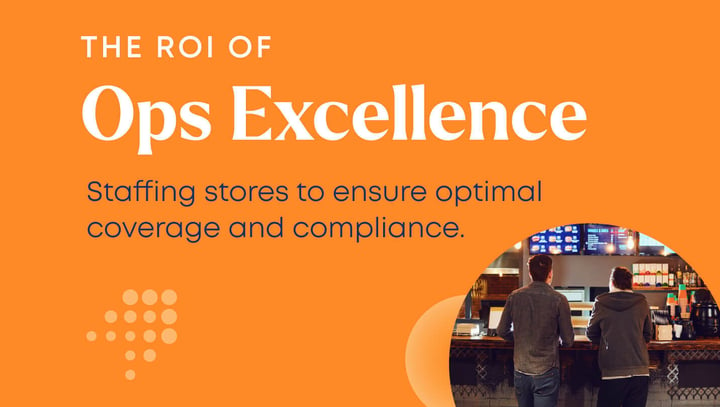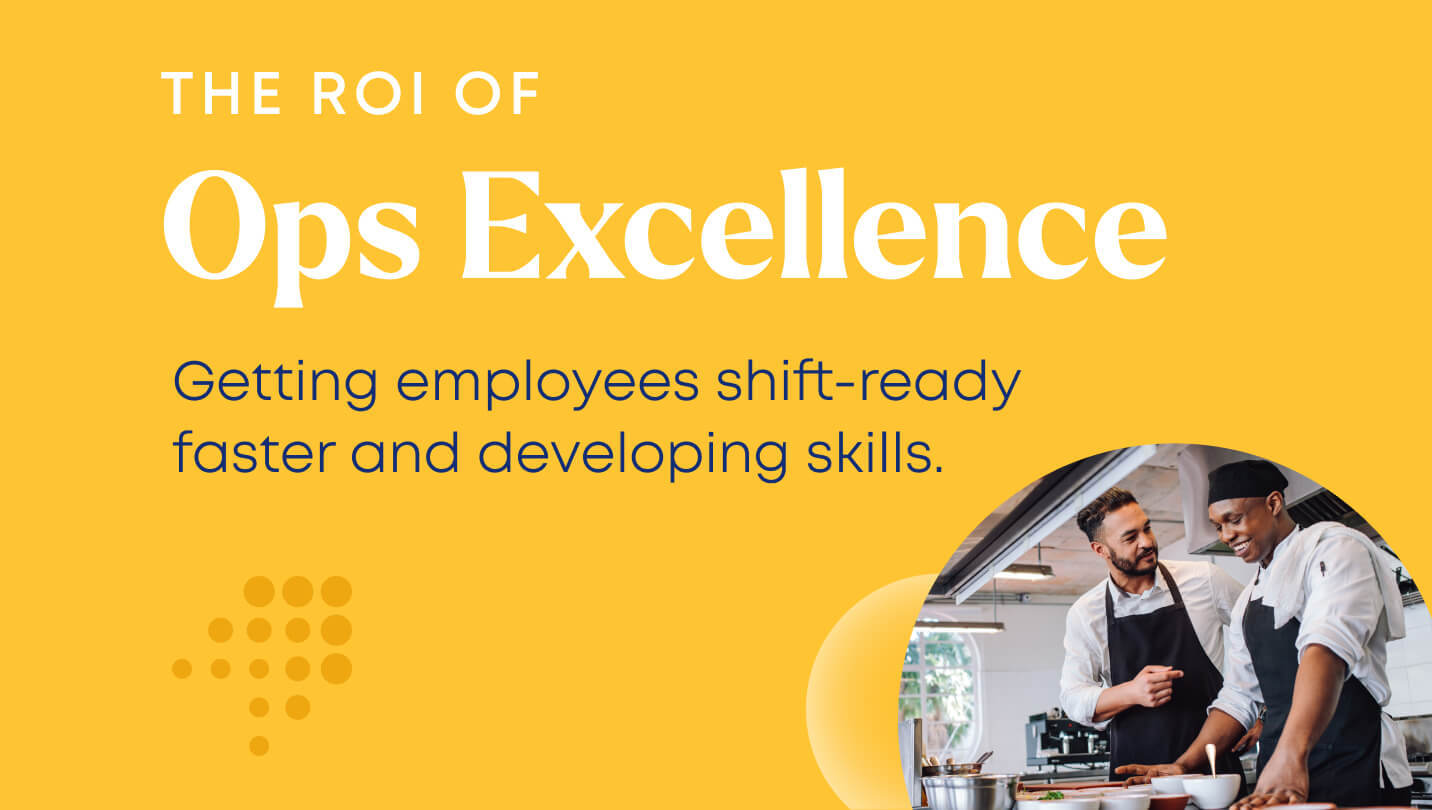
- Home
- Crunchtime Blog
- The ROI of Ops Excellence: How Restaurants Can Measure the Value of Improved Employee Learning and Development

The ROI of Ops Excellence: How Restaurants Can Measure the Value of Improved Employee Learning and Development
This is the final part in a five-part series about understanding the ROI of ops excellence in restaurants.
Throughout this series, we’ve outlined the overall value of ops excellence, explored how better inventory and food cost management impact profitability, looked at the ROI of completing work correctly and on time, and examined the value you can drive through better scheduling and labor management.
In this last part, we’ll shift to discussing the value of providing training that equips your team to do their job well and develops them for their future at your business and learn how to measure the ROI of training and development in restaurants.
Every interaction your employees have with a guest and each process they carry out has the power to impact the guest experience and make an impression about your brand. As a result, there is massive value to be uncovered by delivering training that creates star employees and keeps them engaged long-term.
With planning and investment decisions for 2024 upon us, prioritizing initiatives that power ops excellence will be a key driver of your success. Investing in initiatives that train employees to do their jobs well, develop and retain existing employees, and help you avoid compliance issues across all locations will surely pay dividends for years to come.
But how can you prove that and get the buy-in you need? And, what is the ROI of training and development in restaurants?
To make the business case and get these initiatives approved, start tracking these key outcomes to see how improved learning and development can impact customer experiences and your bottom line:
- Get employees shift-ready faster
- improving employee retention at all levels
- Reduce compliance issues
Get employees shift-ready faster
In a fast-paced environment like a restaurant where the guests are always walking through the door, it’s critical to impart knowledge of standard operating procedures onto employees quickly and effectively. Getting them trained up and ready faster, gets them out onto the floor as soon as possible and allows them to start using what they know to have an impact on the guest experience right away. Here are a few outcomes you can expect from a learning and development initiative that will indicate that you’re getting employees shift-ready faster:
Faster time to value
Most brands will have a mix of their own training content and courses mandated for compliance that, once completed, mean that an employee can be considered sufficiently trained to start serving guests. To measure the impact of your learning and development initiative on getting employees shift-ready quickly, simply count how many days of employment or hours of training on average it takes employees to reach this point of being “trained.” A reduction in training time will show that your brand has decreased the time to value for each employee.
Increased quality of the guest experience
How do we define “shift-ready”? When an employee is shift-ready, they’ve learned and validated all the knowledge they need to know in order to provide a great customer experience, every time. Some of the best ways to measure the quality of the guest experience are by using third-party review sites with customer ratings or feedback tools that deliver guest satisfaction scores.
As a result of rolling out a learning and development initiative that scales to all your brand’s locations, guests (and future reviewers) will be getting the experience they expect, because it will be consistent with what they know about your brand or their experience with other locations. Most importantly, your employees will also be trained to provide them with an excellent experience from the moment they walk in. Track any increase in customer rating on top third-party sites like Google, Yelp, or delivery platforms to prove the return on your learning and development initiative. Or use a research provider or feedback tool to measure and track changes to guest satisfaction scores over time.

Improving employee retention at all levels
Operations leaders know that churn is expensive, and it’s more cost-effective to keep a good employee you already have than it is to go find a new one and hire them.
With a typical cost of $1,800 - $2,000 per employee, replacing them adds up quickly. For a restaurant that has an average of 50 employees per location with 100% turnover, a modest 10% improvement in retention means hiring five fewer employees per year. That is a savings of $9,000 per location. If they have 100 locations, that's $900K in ROI, which is more than enough to cover the cost of a Learning Management System (LMS) and training content.
Use the following metrics to measure this outcome.
Increased retention and decreased churn
Equipping your team with the training they need to do their job well and feel successful each day is a key way to keep them engaged for longer. Once you have employees that are consistently performing well and may be looking for the next step, you’ll want to make sure that your learning and development initiative supports a method for identifying these rising stars and providing them with additional development for their next role.
To measure the impact of this outcome on your business, track employee retention. An increase in retention or a decrease in churn will prove the return on your learning and development initiative investment.
Increased number of internal hires
In addition, your business may also choose to begin tracking the source of higher-level hires in order to compare the number that were developed internally vs. the number that were outside hires. An increase in the share of these employees that are developed internally would indicate a positive impact from your learning and development initiative.
Reduce compliance issues
A business can’t run unless it’s in compliance with all applicable laws, and ops leaders need a way to effectively deliver compliance training and make sure it's completed on time by every employee. Use these metrics to help determine if your learning and development initiative is impacting compliance:
Increased third-party audit scores
Falling out of compliance will usually result in detractions from a third-party audit score or fines when the issue is discovered. Begin tracking the number and cost of compliance issues that surface to prove that your training initiative is decreasing compliance issues, or track any increase in audit scores that are associated with deploying your learning initiative.
Reduced risk of non-compliance
The most effective learning and development solutions will provide an easy way to track compliance needs per employee and allow employees to quickly access the right training in order to be compliant so that it doesn’t fall through the cracks. Ideally, the solution should automatically reassign recurring training at required intervals to make ongoing compliance seamless. Additionally, the solution must allow ops leaders to quickly identify which employees are at risk for noncompliance.
By leveraging a solution like this, compliance issues can be addressed proactively, before they end up reflected on an audit or result in costly fines or lawsuits. Measure the return on your learning initiative by tracking the number of employees who become at risk for compliance issues and require intervention. With a learning and development solution that makes the right training easily accessible to them, your business will likely see this number decrease.

Now that we’ve outlined how to measure the ROI of training and development in restaurants, wherever you are in your process of implementing a learning and development initiative, you can use these expected outcomes and success metrics to your advantage. If a training initiative is just getting started, use these expected outcomes to build your business case and communicate with internal stakeholders about the value you expect an initiative like this to return.
If you’ve already kicked off a learning and development initiative at your business, use these ideas for metrics to track your success and ultimately prove the return on investment of employee training. Get in touch with us for a customized demo when you’re ready to see how Crunchtime can help you get employees shift-ready faster and keep them longer in your stores.
We hope you found this five-part series helpful as you navigate through strategy and budgeting discussions with your leadership team. To revisit any of the five parts of the series again, visit crunchtime.com/blog.
Share this post
Related


Save Time, Empower Employees, and Maintain Compliance with Restaurant Scheduling Software


